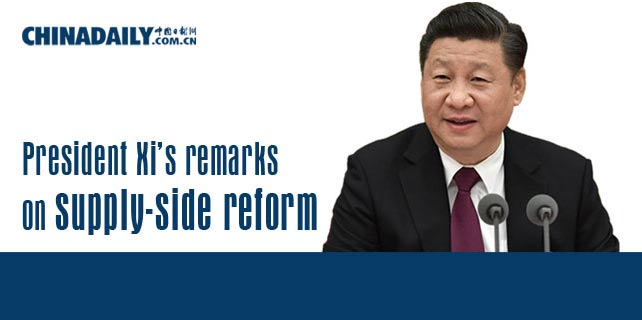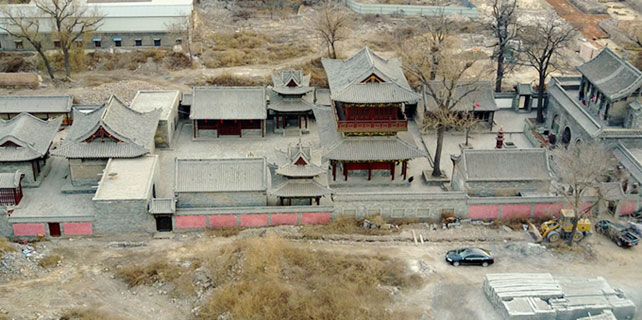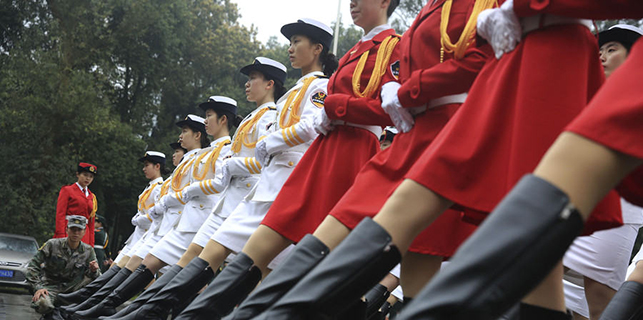China's economic structural reforms boost opportunities for global growth
BEIJING - China will build on the forward momentum and continue its economic structural reforms in 2017, in an effort to provide more opportunities for global growth.
Deepening supply-side structural reforms, aimed at mid- and long-term stable growth, will remain at the center, according to this year's government work report, which sets the GDP growth target for 2017 at around 6.5 percent.
Supply-side structural reforms
China's supply-side reforms started in 2016. Among the efforts, capacity reduction will this year expand from coal and steel industries to sectors including coal-fired power, building materials and nonferrous metal, said the National Development and Reform Commission on March 6.
The government work report urges a decisive market role and an improved government role in resources distribution so as to secure progress in this area.
"Aiming to resolve bottlenecks blocking mid- and long-term growth, the supply-side reforms are timely and necessary for a sustainable growth in China," Selcuk Colakoglu, head of Asia-Pacific Studies at the Ankara-based International Strategic Research Organization, said in a comment.
Former Indonesian vice foreign minister Dino Patti Djalal said,"The resulting economic upgrading will bring more opportunities to the global growth."
Changes are believed to be directly and soon felt in future prices on world markets, of the bulk commodity in particular, as China is the world's second largest economy, as well as the largest coal consumer and steel producer.
For example, China's supply-side reforms last year contributed to an aluminum price hike.
"That (the reform) brings all of us in the industry to a healthier situation, when we see the new levels of prices," Vladislav Soloviev, CEO of the world's leading aluminum producer RUSAL of Russia, told Xinhua during the World Economic Forum (WEF) held in January in Davos, Switzerland.
He attributed the price rise to an expanding demand in all markets especially China, and was confident about sharing a bright future of China's reforms.
"The market is growing, economic reform is happening, there are a lot of infrastructural reforms ...That's why we are quite optimistic about the demand of the future, also about joint ventures with Chinese companies," he said.
Innovation-focused upgrading of economy
It is China's priority to transform and upgrade the real economy in order to release potentials for a sustainable growth. The government work report demands innovation take the lead, which is expected to see new concepts, management modes and technologies.
"Problems in the real economy have their roots in a lack of innovation," said Zhou Guohui, deputy of the 12th National People's Congress and head of the provincial science and technology department of Zhejiang in east China.
He believed innovation highlighted developing new and high tech industries so as to open up more growth spaces, as well as transforming traditional industries with the information technology.
The reforms were challenging for such a developing economy as China, as it was turning into a leading first-class digital economy and the world's manufacturing powerhouse, Joe Kaeser, President and CEO of German giant Siemens, has said.
Apart from new technologies, innovation involved labor force retraining, he said, noting that Germans would like to share the experience for a smooth transition they went through in 1950s and 1960s.
"We are very eager to bring modern manufacturing software to Chinese manufacturing so they are more efficient, high quality and high scale," the Siemens CEO added.
The world expects to see a successful economic upgrading in China, because it is vital to China's growth, and in turn to global growth amid uncertainties largely from a sluggish global economic recovery and a surge in anti-globalization and protectionism in western countries.
"The planned growth level will help keep China's contribution to the global growth at around 30 percent, and this will help avert an economic depression worldwide," said Mihail Delyagin, director of the Russian Institute for Globalization Problems.
Indonesia's economist Yudhoyono Firmanzah, a former presidential economic adviser, said that as Indonesia's biggest trade partner, each one percent of China's GDP growth would be translated into 0.3 percent of that in the southeast Asian country.
A green economic upgrading
The government work report also holds environmental protection as a key factor in China's economic upgrading, to meet people's urgent demand for better environment, especially cleaner air.
Moreover, this serves as a driving force, NPC deputy Zhou said.
For example, economic mode changes entail cutbacks in coal consumption while working to improve energy efficiency. Official data showed a continuous fall in coal use in the past three years in China, where energy use was however up 1.4 percent only for a 6.7 percent growth last year.
China plans this year to close down, halt and delay coal-fired power capacity of at least 50 million kw in total, while quitting coal production capacity in excess of 150 million tons.
In a larger sense, this means China will contribute more to the global fight against climate change.
Macharia Munene, a Nairobi-based foreign relations scholar, praised the latest Chinese move to meet environmental challenges.
As part of innovation efforts, China is taking measures including use of green technologies to mitigate climate change and reduce air pollution, he told Xinhua recently.
China's economy is moving to "a lighter economy, a modern economy, and this is also reflected in the Chinese energy portfolio very much," Fatih Birol, executive director of the International Energy Agency, has said.
"I think some of the reforms, some of the steps China is making can also be an inspiration for other countries in the world, " he said, while noting a slowdown in energy demand growth as well as big and rapid leaps in the development of clean energies in China.









